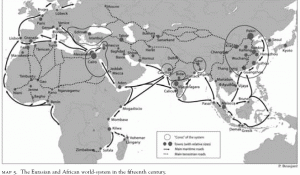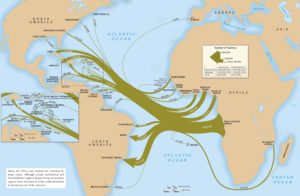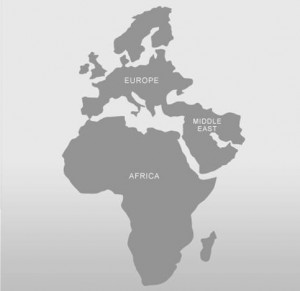
In order to understand the mass enslavement of African people during the 15th to 19th centuries, we must first interrogate the historical circumstances that made it possible for 15th century European trading partners to dominate African empires and create the nightmarish conditions that came to characterize future generations. It is important to note that human phenomena do not occur in isolation, they are a result of socio-historical circumstances that emerge through time and across space (Marcus and Fisher 1980). What this means is that events do not occur out of nowhere, they are the outcome of specific social and historical circumstances that create the conditions for those events to take place. This lesson will address the socio-historical recipe leading up to the enslavement of African people and the occupation of African territories.
Lesson Objectives
- describe African and Europe interconnections through trade and the role of European and Arab competition for territory, resources and labor
- recognize the relationship between the trade triangle, the plantation economy, and the mass enslavement of African people
- describe African and European relations in the region surrounding your selected country prior to 1900
Civilizations & Kingdoms
The previous lesson mentioned that agriculture led to more sedentary lifestyles which increased the population of human settlements. Human settlements grew into complex ‘civilizations’ characterized by hierarchical relations. This is also known as social stratification; different social groups experienced different rights and entitlements within the society. In most cases, civilizations were governed by an elite minority who enjoyed more privileges, rights and entitlements than other social groups. This came to be the case in kingdoms that developed in Europe, Asia, the Middle East, and Africa. Many of these kingdoms included a social category of people who were referred to as ‘slaves.’ People who were enslaved in these kingdoms were sometimes traded within existing trade networks between the kingdoms. As kingdoms became empires, however, the nature of enslavement and the number of people enslaved changed dramatically.
Like international relations today, the relationships between early kingdoms were generally based on both dependency and competition. The kingdoms depended on one another in order to acquire goods that were not available in their immediate region. The previous lesson mentioned that West African kingdoms traded gold and salt to Nile Valley regions to acquire copper. Kingdoms throughout Africa also traded with kingdoms in Europe, Asia and the Middle East through extensive maritime and overland trading networks. Maritime shipping and ports along the coast connected to on-land caravans within the interior. Although trading networks connected the kingdoms and facilitated the movement of people and resources, rapid population growth and the ever-increasing need for more resources required kingdoms to expand their territories. This frequently generated tensions and conflicts between trading partners. Rising tensions between rapidly expanding kingdoms on the small European continent launched an era of European imperialism that shaped world history and the contemporary era
The 15th century launched the era of European expansion. Heightened tensions between Christian kingdoms in Europe and Islamic kingdoms in the Middle East prompted European and Arabic voyages to secure stronger trade relations with African kingdoms and acquire resources for their growing empires. Portuguese traders established posts in Cape Verde (1460), the Gold Coast (1471), Kongo (1483), and the Cape of Good Hope (1488). Vasco da Gama entered into East Africa (1497), while Spain paid an Italian Captain named Christopher Columbus to establish territories in the Americas (1492). European monarchies set across the Atlantic to establish new territAs European kingdoms expanded and acquired more territory, they began to compete with each other outside of Europe. By the 16th century, Dutch, British and French traders established posts in Africa which pushed Portugese traders to Asia. At the same time, Arab traders were establishing trading posts along Africa’s Eastern seaboard. African kingdoms were caught in the center of the competitive expansion.
African Enslavement and the Triangular Trade Routes
As European traders established trading posts and trade relations with African Kingdoms along the western seaboard, European militaries established colonies in the Americas. British, French, Spanish and Dutch convoys seized territory from indigenous (Native) Americans and created European settlements along the eastern seaboard of what is now known as the United States, as well as the Caribbean, Central America and South America. This is known as The Conquest, and during this time the vast majority of indigenous people were decimated by European diseases that swept across the continent.
Throughout the 16th century, Europeans established plantations in the Americas to produce raw materials, such as sugar, tobacco, coffee, cotton, rubber, and timber for Europe. These crops required extensive labor resources, and the sparse population in the Americans created a labor shortage. Europeans were not able to recruit or enslave Native Americans because European diseases caused high mortality rates among Native Americans. Those who were not encumbered with sickness were familiar with the environment and were able to escape easily. It was difficult to recruit European labor because mortality rates among Europeans in the Americas was extremely high because most Europeans had little or no resistance to the diseases that flourished in the tropical areas of the Americas such as malaria. African people, however, were quite resistant to tropical diseases in the Americas due to long term exposure to those diseases in tropical areas of Africa. In addition, long term trade relations with Europeans in Africa helped African people develop resistance to European diseases. Europeans discovered that enslaved African people were able to endure the extensive labor demands on agricultural plantations and the lack of familiarity with the American landscape made it difficult for enslaved African people to escape. As the colonization of the Americas increased, the demand for African labor escalated. The growth and development of the European Empire, which was comprised the European colonies and the massive accumulation of wealth, was built with the labor of African people, and European dependency on enslaved African labor increased rapidly as European empires expanded across the globe. The two-minute video below provide a visual representation in the rapid increase in demand for enslaved labor over time.
The triangular trade system in the 18th and 19th centuries involved shipping goods from Britain to West Africa in exchange for enslaved people who were in turn taken to the Americas to produce raw materials that were shipped back to Europe. The video below explains how the triangular trade system led to massive accumulation (and power) in Europe and the depletion of resources in Africa. The plantation economy provided the economic motivation for Europeans to engage in forced labor during colonization, and the increased demand for labor in the Americas increased the demand for enslaved people from Africa. In his book, Capitalism and Slavery (1944) Eric Williams argues that Caribbean slave labor not only built Britain’s sugar trade, but the institution of slavery helped build the British empire.
“Negro slavery therefore was only a solution, in certain historical circumstances, of the Caribbean labor problem. Sugar meant labor – at times that labor has been slave, at other times nominally free; at times black, at other times white or brown or yellow. Slavery in no way implied, in any scientific sense, the inferiority of the Negro. Without it the great development of the Caribbean sugar plantations, between 1650 and 1850, would have been impossible.” (Williams 1944)
African Slave-Trader Controversy
African kingdoms were complex, stratified societies tied to a world economy. Through trade networks, nobles and aristocracy were able to acquire manufactured and luxury items such as cloth, jewelry and other goods from Europe. European demand for labor in the Americas increased the demand to trade enslaved people in Africa. African kingdoms had historically engaged in slavery, yet the conditions for enslavement varied cross-culturally. Nonetheless, as the European demand for enslaved people increased, the number of people traded to the Europeans increased. In his PBS TV series, Wonders of The African World, Harvard Professor of African-American History, Henry Louis Gates Jr, offers a very controversial explanation for the role of African kingdoms in the mass enslavement of African people. According to Gates, the enslavement and exportation of millions of African people was made possible by collaboration with African kingdoms and African traders who participated in trade with European people. His historical account has ignited controversy and harsh reactions by historians and activists such as M.K. Asante, professor of African-American Studies at Temple University. Asante’s article, Henry Louis Gates is Wrong About African Involvement in the Slave Trade, points out that ‘the motive for kidnapping and transporting Africans across the ocean was a European initiative.’ He argues that it was the Europeans, not the Africans, who created an economy based on enslaved labor. He also describes how several African leaders, such as Nzinga, a queen of the Mbundu in the kingdom of Ndongo, led armies to attack and expel European traders. Although the role of African kingdoms in the enslavement of African people is debatable, the fact remains that millions of African people were taken from their families and forcibly deported several thousand miles away.
Enslavement & Exportation
Slave ports were primarily located along the West African seaboard, and the vast majority of enslaved people deported to the Americas originated from the Western coast, the southern region and the Interior. While approximately seven million people were enslaved and deported by Arab traders operating along the North Eastern Horn of Africa, 15-20 million people were sent to the Americas (five million arrived in the United States). Two-thirds of the population were men, and the average life expectancy ranged from five to seven years.
The Ted-Ed video below provides a brief overview of the ways that the trade triangle and the mass enslavement of African people over several centuries eventually led to the erosion and decline of African civilizations.
‘Slave’ versus Enslaved
It is important to consider the language that we use when we refer to the millions of people who were forcibly removed from their homeland and sent to the Americas to endure hard labor and extreme exploitation. Historical accounts describe the ways that, upon arriving in the Americas, African people were forbidden to use their native languages, keep their names, practice their culture and religion, or engage in behaviors that were connected to their African identity. Contemporary scholars point out that the use of the word ‘slave’ or ‘slave trade’ perpetuates the practice of stripping people of their social, linguistic, ethnic and family ties and defining people as a ‘slave’. No one is born a slave or chooses to take the identity of a slave. People or forced into slavery, or enslaved. By changing from the use of a name – slaves – to an adjective – enslaved– we grant these individuals an identity as people and use a term to describe their position in society rather than reducing them to that position. In a small but important way, we carry them forward as people, not the property that they were in that time.
Resistance
As M.K. Asante has pointed out, there was a tremendous amount of resistance to enslavement and occupation in Africa and among enslaved Africans in the Americas. The most successful slave rebellion in history was the 18th-century Haitian Revolution, led by Toussaint Louverture and later Jean-Jacques Dessalines who won the war against their French colonial rulers, which founded the country formerly known as Saint Domingue. Nanny of the Maroons was an 18th-century leader who rebelled against the British in Jamaica; and the Quilombo dos Palmares of Brazil flourished under Ganazumba (Ganga Zumba). The 1811 German Coast Uprising in the Territory of Orleans was the largest rebellion in the continental United States; Denmark Vesey rebelled in South Carolina, and Madison Washington during the Creole case in the 19th century United States. Numerous African slave rebellions and insurrections took place in North America during the 17th, 18th, and 19th centuries. There is documented evidence of more than 250 uprisings or attempted uprisings involving 10 or more slaves.
There are nearly 500 recorded instances of slaves revolting on board slave ships. In many instances, the enslaved captives were able to take over the ships and regain their freedom. On October 5, 1764 the New Hampshire ship Adventure captained by John Millar was successfully overcome by enslaved people on board who revolted while the ship was anchored off the coast. All but two of the crew, including Captain Millar, succumbed to disease. Another successful slave revolt occurred six days after the ship Little George left the coast of Guinea. The ship carried ninety-six enslaved people, thirty-five were male. The enslaved people attacked early morning and overpowering two crew men on guard. After taking control of the ship they sailed it up the Sierra Leone River and escaped.
The movie, Amistad, depicts the true story of a successful rebellion that took place aboard a ship that was in transit across the Atlantic. The ship made landfall in North America, and the Spanish claimed the people on board as property. The ensuing court case tested American principles of liberty and equality against the widespread practice of enslavement during the 18th and 19th centuries.
Race & Racism
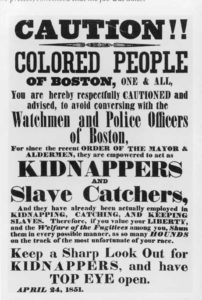
In order to justify the hypocrisy of practicing slavery in a society that claims to value liberty and equality, European and American scientists and scholars created propaganda for the moral justification to enslave people by representing people as inferior, backward and incapable of self-governance. During this time, ‘Race Science’ emerged and a wide range of so-called ‘scientific’ evidence was produced to justify occupation and exploitation of people. Although you will not be tested on Race Science, feel free to explore the webpage to learn more about the ways that pseudo-science has been used to marginalize oppressed people and consider the long-lasting effects that it has created in society today.
Abolition and Informal Trade
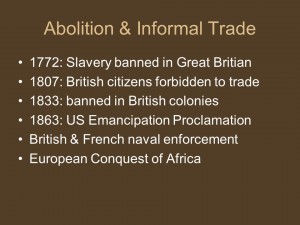
The injustice of enslavement ignited abolitionist campaigns throughout Europe and the Americas. Yet abolition, or the end of enslavement, took more than a century. Slavery was banned in Great Britain in 1772, but it was not until 1807 when British citizens were forbidden to trade. Nearly 30 years later, in 1833, slavery was banned in British colonies and in 1863 U.S. President Abraham Lincoln delivered the US Emancipation Proclamation that ignited a bloody American Civil War. Throughout that time, traders continued to import enslaved people illegally until British and French naval enforcement made it too risky to import African people. Cut off from free labor in the Americas, Europeans set their sights on the territories and land of their African trading partners.
African-European Relations: from trade to conquest
The enforcement of abolition in the Americas launched the European conquest for colonization in Africa. Agricultural crops and raw materials produced on plantations in the Americas, such as palm, peanut, rubber, coffee, cotton, beeswax, and cereals were introduced to plantations throughout Africa. By the 20th century, people living in Africa had been experiencing more than 300 years of human enslavement and exportation. The forced removal of millions of men over several generations impacted the population in many areas throughout West Africa and the interior. Villages were comprised of more women than men, and the decreased population affected economic activities and agricultural production. Demographic change and the stress imposed by massive enslavement created internal conflict within villages and weakened African kingdoms. While at the same time, the Trade Triangle generated significant wealth for European kingdoms and launched the development of firearms, medicine and transportation technologies. This changed the relationship between European and African kingdoms and set the state for European colonization of Africa throughout the twentieth century.
References and Resources
To learn more about African-European relations prior to 1900, explore the links below.
- Asante, M.K. ‘The Slave Trade and Reparations: closing the Gates.’
- The Slave Revolts. Nybooks.com.
- “An Historical Account of the Black Empire of Hayti: Comprehending a View of the Principal Transactions in the Revolution of Saint Domingo: with Its Ancient and Modern State”. World Digital Library.
- “Nat Turner’s Rebellion”. PBS.
- “Bahia Revolt”. africanholocaust.net.
- “Home”. The Slave Rebellion Website.
- “Welcome to Encyclopædia Britannica’s Guide to Black History”. Encyclopædia Britannica.
- The Transatlantic Slave Trade Database
- “Triangular Trade”. National Maritime Museum.
- “Death Toll From The Slave Trade”. World Future Fund.
- Whatley, Warren C. (2017). “The Gun-Slave Hypothesis and the 18th Century British Slave Trade” (PDF). Explorations in Economic History. 67: 80–104.
- Slave Voyages, Trans-Atlantic Slave Trade – Estimates
- Mintz, Sidney. Sweetness and Power: the place of sugar in modern history
- BECKLES, HILARY. “Capitalism and Slavery: The Debate over Eric Williams.” Social and Economic Studies, vol. 33, no. 4, 1984, pp. 171–189. J
For Discussion in Canvas
Describe the pre-colonial history of your selected country in approximately 250 words or more. Who were the trading partners and what goods were traded? Was there a resistance movement to mass enslavement that originated in your selected country? Do not forget the class requirement to include formatted references and in-text citations for your sources and to respond to at least two other student posts.

